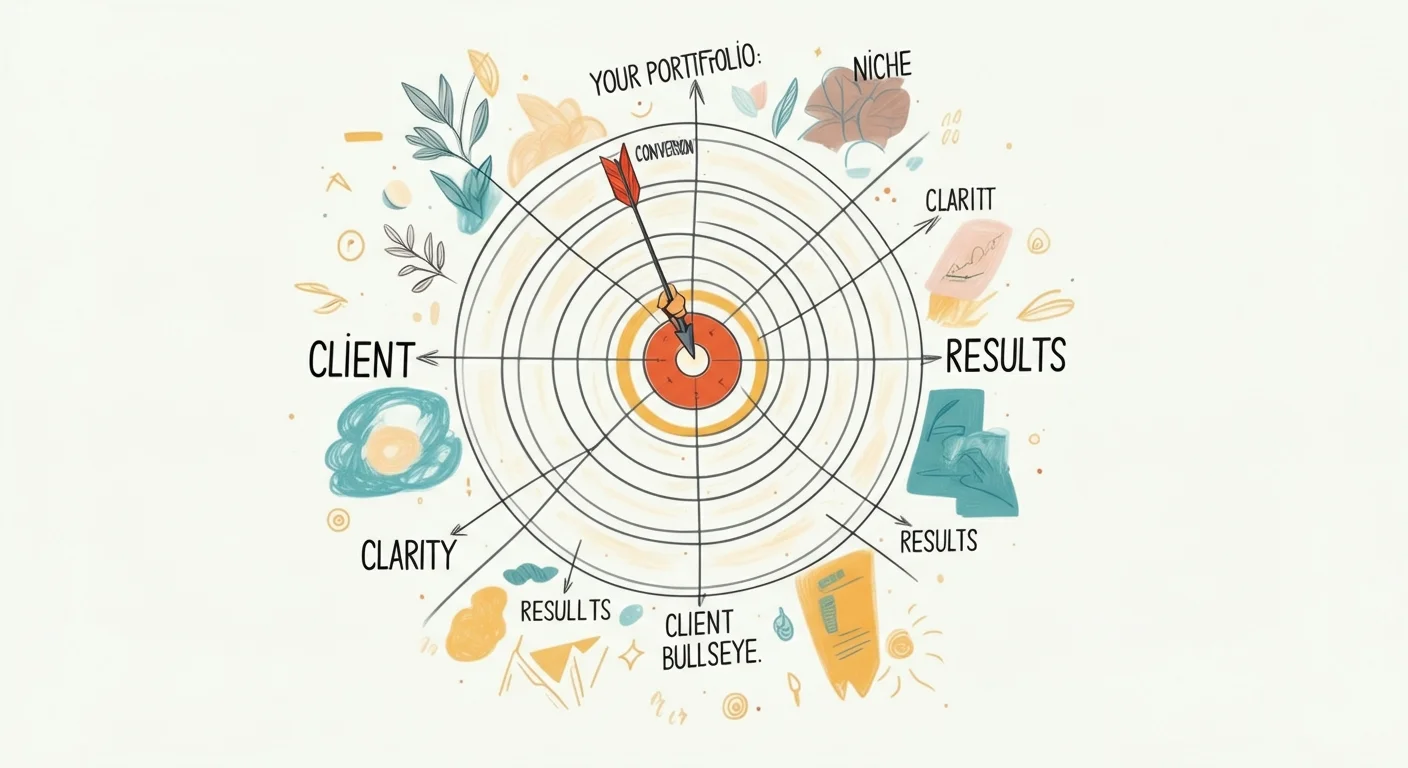In the dynamic and increasingly competitive world of freelance work in 2025, your freelance portfolio is far more than just a collection of past projects. It is, without a doubt, your single most powerful sales tool. Why? Because potential clients often form their crucial first impression of your skills, professionalism, and credibility based almost entirely on what they see in your portfolio. A meticulously crafted online portfolio doesn't just showcase your talent; it actively answers the essential question on every client’s mind: “What can you do for me? What’s the value you’ll bring?”
This comprehensive guide will walk you through exactly how to create a freelance portfolio that doesn’t just sit idle but actively converts curious visitors into high-paying, long-term clients. Whether you’re a designer, writer, developer, marketer, or consultant, these proven tips will help you build a portfolio that truly gets noticed and drives client acquisition in 2025.
What Makes a Freelance Portfolio Sell? The Science of Conversion

A portfolio that genuinely converts isn't merely a visually appealing gallery of your best designs or a long list of projects. It's a strategically engineered marketing tool that meticulously communicates your unique value proposition and directly addresses client pain points. Here’s what makes a portfolio truly effective and results-driven:
Clarity: Instant Understanding: Can a client, within seconds, instantly understand what you do, who your ideal client is, and the specific problem you solve? Ambiguity kills conversion. Your headline and opening statement should be crystal clear.
Example: Instead of "I do design," say "I craft intuitive SaaS dashboards that boost user retention."
Specialization: The Power of Niche Are you trying to appeal to everyone, or do you focus on a specific niche or industry? Clients seek specialists, not generalists. A specialized portfolio signals expertise and makes you the obvious choice for a particular need. This is crucial for effective personal branding.
Results: Impact Over Output: Clients care less about what you did and more about the impact it created for previous clients. Don't just show outputs (e.g., a logo); show tangible outcomes (e.g., "Increased brand recognition by 25% within 6 months"). Focus on measurable results and tell the story behind them using compelling case studies.
Visual Appeal & User Experience (UX): A clean, modern design, intuitive navigation, and fast loading times keep visitors engaged. If your portfolio itself is poorly designed or hard to use, it undermines your professional credibility, regardless of the quality of your work. Ensure it's mobile-responsive.
Strategic Positioning: You Are the Solution Present yourself not just as a service provider (someone who does work) but as a solution to the client’s pressing problem (someone who solves problems and drives results). This shift in perspective makes you indispensable.
Trustworthiness/Social Proof: Why should they trust you? Client testimonials, success metrics, and relevant accolades build immense trust and act as powerful social proof.
Clear Call-to-Action (CTA): What do you want visitors to do next? Make it incredibly easy for them to take that next step, whether it's booking a call, requesting a quote, or sending an email. Ambiguity here loses leads.
Your portfolio isn’t just an introduction; it’s a compelling promise of the tangible value and measurable results you can deliver.
Choose the Right Format for Your Niche: Tailor Your Presentation
The format of your freelance portfolio should directly align with your specific niche, the type of work you do, and, most importantly, the preferences of your target clients.
Website Portfolio (Most Recommended for 2025):
Ideal For: Most freelancers, including creatives (designers, photographers, videographers), marketers (content strategists, SEO specialists), developers, and consultants who want complete control over their personal branding and presentation.
Pros: Ultimate control over design, SEO capabilities, can integrate blog posts, online booking forms, and multiple CTAs. The professionalism factor is high.
Cons: Requires more setup time and potentially a small monthly/annual fee for hosting and domain.
Platforms:
Squarespace: Excellent for visually driven portfolios, very intuitive for non-coders.
Wix: Drag-and-drop builder, highly customizable, good for diverse needs.
WordPress.org (self-hosted with themes like Astra, GeneratePress, and Kadence): Most flexible, powerful for SEO and blogging, but requires more technical savvy.
Webflow: Powerful for designers who want to build custom, responsive sites without writing code.
One-Page PDF Portfolio:
Ideal For: Writers, virtual assistants, consultants, or anyone applying for specific jobs where a concise attachment is preferred. Great for cold outreach.
Pros: Easy to attach to emails/proposals, quick to consume, highly portable.
Cons: Less interactive, harder to update frequently, no SEO benefits.
Tools: [suspicious link removed] (templates available), Google Docs, Adobe InDesign.
Specialized Portfolio Platforms:
Ideal for designers (graphic, UI/UX), illustrators, photographers, and developers (for code showcases).
Pros: Built-in exposure to potential clients actively searching for specific talent, strong community features, and can serve as a primary or supplementary portfolio.
Platforms:
Behance (Adobe): Widely recognized for showcasing creative work.
Dribbble: Popular for UI/UX and product design.
GitHub: Essential for developers to showcase code repositories and contributions.
ArtStation: For game artists, concept artists, and illustrators.
LinkedIn Profile as a Portfolio:
Ideal for consultants, coaches, virtual assistants, marketers, or anyone primarily seeking B2B clients and networking opportunities. Excellent starting point.
Pros: Already a professional networking hub, easy to update, can attach media files, and integrate testimonials directly.
Tips: Use the "Featured" section to highlight key projects, articles, or media. Optimize your headline and "About" section as if they were your portfolio's core messaging.
Your choice of format should strategically balance functionality with your ability to easily update and maintain it, ensuring it always presents your best work.
Structure of a High-Converting Portfolio: The Client-Centric Flow
A meticulously structured portfolio resonates with clients because it's simple to follow, answers their most pressing questions quickly, and guides them towards action. Think of it as a carefully designed sales funnel. Here’s how to build one step by step:
Compelling Headline (Above the Fold):
Your headline is your elevator pitch. It must instantly tell the client, "Who do you help, and how do you help them achieve a specific result?"
Examples:
"I help SaaS startups generate qualified leads with data-driven SEO content strategies."
"Creating standout, user-centric brand identities for modern e-commerce businesses."
"Streamlining operations for busy entrepreneurs through expert virtual assistant services."
Why it sells: This immediately tells clients you understand their needs and have a clear value proposition.
Concise "About Me" Section:
Keep it short, professional, and client-focused. This isn't your life story; it's why you're the right person for their project.
Include your core expertise, your niche specialization, years of experience, and any relevant certifications or accolades. Infuse a touch of your personal branding and values.
Example: "With seven years of dedicated UX design experience, I specialize in crafting intuitive, conversion-driven interfaces for e-commerce brands, leading to enhanced user satisfaction and increased sales."
Why it sells: Builds credibility and gives context to your expertise.
Clear Services Offered:
Provide a list of your specific services, along with brief, benefit-oriented descriptions. Avoid jargon.
Examples:
SEO Content Writing: "Optimized articles and blog posts that not only boost your Google rankings but also convert readers into customers."
Logo Design: "Memorable, scalable brand marks that authentically reflect your brand identity and resonate with your target audience."
Custom Web Development (WordPress): "Building secure, high-performing, and easily manageable WordPress websites tailored to your unique business operations."
Why it sells: Helps clients quickly identify if you offer what they need and clarifies your specific offerings. Consider packaging services for higher value.
Strategic Portfolio Samples/Case Studies (The Core):
Quality over Quantity: Showcase 3–5 of your absolute best projects that directly align with the type of clients you want to attract.
For each sample, include a mini-case study: This is where you tell the story of your work, using the STAR method (Situation, Task, Action, Result).
Context/Situation (Problem): What was the client's challenge or goal? (e.g., "Client was struggling with low organic traffic and stagnant lead generation.")
Your Task/Action (Solution): How did you approach the project? What specific steps did you take? What was your unique methodology? (e.g., "I conducted extensive keyword research, developed a 3-month content strategy, and wrote 12 long-form SEO-optimized articles.")
Results (Measurable Outcomes): This is paramount. Quantify your impact. (e.g., "Within 3 months, organic traffic increased by 60%, and qualified lead conversions rose by 30%.")
Visual Presentation:
Designers/Developers: High-quality screenshots (Figma, Sketch, live site demos), before-and-after comparisons, and process mockups.
Writers/Marketers: Links to live articles, screenshots of analytics (page views, time on page, conversion rates), email open rates, and social media engagement metrics.
Consultants/VAs: Visual representations of improved workflows, redacted reports, and client testimonials highlighting specific results.
Why it sells: It proves your capabilities, demonstrates problem-solving skills, and provides tangible evidence of your value.
Compelling Client Testimonials (Social Proof):
Social proof is incredibly powerful for building trust and credibility. Include glowing reviews or feedback from past projects.
If you don't have testimonials yet, ask colleagues, former employers, or even friends/family for reviews on a volunteer project (see next section).
Aim for specificity: "John helped me increase conversions by 15%!" is better than "John is great."
Why it sells: It validates your claims and assures potential clients that others have had positive experiences with your work.
Clear Call-to-Action (CTA):
End your portfolio with an undeniable invitation for clients to take the next step. Make it prominent and easy to find.
Examples:
"Ready to discuss your project? Schedule a free discovery call with me here." (Link to Calendly/Acuity)
"Have a question or need a custom quote? Contact me directly at [your professional email]."
"Let's elevate your brand. Get started today!" (Link to a contact form)
Why it sells: Guides visitors from browsing to becoming a qualified lead, directly contributing to your client acquisition.
Every section of your portfolio should be designed with the client’s needs and questions in mind, streamlining their journey from curious visitor to paying customer.
What to Do If You Don’t Have Clients Yet: Building Your Initial Portfolio
Launching your freelance portfolio without a trove of past client projects can feel intimidating, but there are highly effective ways to showcase your skills and demonstrate your potential:
Mock Projects/Fictitious Case Studies:
Concept: Create hypothetical projects that solve real-world problems for your ideal client.
Example (Designer): Redesign a poorly designed website for a local restaurant, showing before-and-after mockups and explaining your design choices.
Example (Writer): Write a blog post for a specific (imaginary) SaaS company targeting their ideal customer, complete with keyword research and an outline of your content strategy.
Example (Developer): Build a small app or tool that addresses a common problem in your chosen niche.
Key: Focus on explaining your process and approach. Clients care as much about how you work and solve problems as they do about the final output. Document your thought process, research, and decisions.
Volunteer or Pro Bono Work:
Concept: Offer your services to nonprofits, charities, friends, or very small businesses for free or at a significantly reduced rate.
Benefits: You gain real-world experience, build a live project, and, most importantly, secure your first genuine client testimonial.
How: Reach out to local organizations or individuals you know. Be upfront about your intentions (building a portfolio/testimonials).
Redesign Case Studies/Critique Examples:
Concept: Take existing (and perhaps poorly executed) work in your niche (e.g., a bad website, a confusing piece of marketing copy, a clunky app interface) and demonstrate how you would improve it.
Key: Clearly articulate the problems you identified, your proposed solutions, and the expected positive results. This showcases your critical thinking and problem-solving abilities.
Personal Projects / Passion Projects:
Concept: Showcase personal creative endeavors or self-initiated projects that highlight your skills and passion.
Example (Writer): Start a blog on a topic you're passionate about, demonstrating your writing style and ability to drive traffic.
Example (Designer): Create a series of personal illustrations or a unique font.
Example (Developer): Develop an open-source tool or contribute to an existing project.
Document Your Learning Journey:
If you're learning a new skill, document your progress. Share your challenges, breakthroughs, and mini-projects. This positions you as proactive and dedicated.
Remember, every project, paid or unpaid, is an opportunity to refine your skills and add compelling content to your portfolio. Focus on the value you can provide.
Selecting and Presenting Your Best Work: Quality Over Quantity
When it comes to portfolio samples, quality consistently beats quantity. Don't overwhelm clients; impress them with your very best work.
Select 3 to 5 core samples: Choose pieces that truly represent your highest quality work and, crucially, align with the type of clients and projects you want to attract. If you want to do e-commerce design, show your best e-commerce design, even if you've done 20 other types of projects.
Use Metrics & Quantifiable Results: This is a non-negotiable for a portfolio that sells. Instead of just saying, "I improved their website," say,
"Saved the client 10 hours/week on administrative tasks."
"Doubled engagement rates on social media campaigns."
"Ranked #1 on Google for key target keywords within 6 months."
"Increased conversion rates by 15% for their new landing page."
"Reduced customer support inquiries by 20% through improved UX."
Provide Compelling Context and Narrative: For each project, include a brief, engaging narrative using the problem → solution → result framework.
Problem: What challenge did the client face? (e.g., "Client's outdated website led to high bounce rates.")
Solution: What specifically did you do? What was your approach? (e.g., "Designed a mobile-first, intuitive UI, integrating new conversion funnels.")
Result: What was the measurable impact? (e.g., "Increased website traffic by 40% and generated 20% more leads.")
Visual Presentation is Key (Niche-Specific):
Designers/Photographers: Large, high-resolution images. Show mockups, before-and-afters, and process shots (sketches and wireframes).
Writers/Content Marketers: Direct links to live articles, screenshots of analytics (Google Analytics for page views and conversions), heatmaps (Hotjar), or email marketing open/click rates. Show snippets of compelling copy.
Developers: links to live demos, code snippets on GitHub, screenshots of the application, and explanations of technical challenges solved.
VAs/Consultants: Clean, professional layouts for sample reports, workflow diagrams, or redacted project plans.
Effective storytelling transforms good work into undeniable proof of your value and expertise, making your portfolio a truly powerful lead generation tool.
Tools to Build Your Portfolio Website: Effortless Creation
Creating your online portfolio has never been easier, thanks to a wealth of modern, user-friendly tools. Choose one that matches your technical skills, budget, and desired level of customization.
Website Builders (for all niches - most recommended for ease):
Wix: Very intuitive drag-and-drop builder, tons of templates, great for visual artists and small online businesses.
Squarespace: Known for its stunning, minimalist templates and strong visual presentation. Ideal for designers, photographers, and writers.
WordPress.com: Managed hosting version of WordPress, simpler to use than self-hosted. Good for bloggers and content-heavy portfolios.
Duda: Excellent for highly responsive, SEO-friendly websites with robust client management features.
Developer Tools (for tech-savvy individuals):
GitHub Pages: Free hosting for static websites, great for developers to showcase code.
Vercel/Netlify: Platforms for deploying web projects quickly, often used with modern JavaScript frameworks.
Custom Coded Site: For front-end developers, building your own site showcases your skills directly.
Creative Platforms (for visual artists & designers):
Writers and Marketers (content-focused):
Contently: A professional platform for content creators to manage their portfolio and connect with brands.
Journo Portfolio: Simple, clean, and effective for writers to showcase articles.
Medium.com: A popular blogging platform where you can publish articles and link to your best work.
Budget-Friendly/Free Options (great for starting out):
Notion: Highly versatile workspace that can be adapted into a minimalist, clean online portfolio using its page-building features.
[Suspicious link removed]: Design beautiful single-page or multi-page PDF portfolios.
Google Sites: Free, simple website builder from Google.
Pro Tip: Regardless of the tool, consider purchasing a custom domain name (e.g., yourname.com). It enhances your personal branding and professionalism significantly.
Common Portfolio Mistakes to Avoid: Pitfalls That Kill Conversions
Even a strong portfolio can fail to convert if it falls into these common traps. Be ruthless in your self-assessment to maximize your client acquisition efforts:
Being Too General/Lack of Niche: The most common mistake. Saying "I do everything" sounds like you do nothing exceptionally well. Clients want specialists.
Fix: Refine your headline and "About Me" to clearly state your niche and target audience.
Focusing Too Much on Yourself, Not the Client: Your portfolio isn't primarily about your journey; it's about their problems and how you can solve them.
Fix: Shift the language from "I did this project" to "I helped client X achieve Y result." Emphasize benefits, not just features.
Poor Design, Clutter, or Outdated Aesthetics: If your portfolio itself looks bad, outdated, or is hard to navigate, it immediately damages your credibility, especially for visual roles.
Fix: Use a clean, modern template. Ensure fast loading speeds. Prioritize white space. Get feedback from others.
No Measurable Results: Simply showing pretty work without quantifying the impact is a missed opportunity to demonstrate value.
Fix: Always include metrics, percentages, or concrete numbers in your case studies.
Missing or Hard-to-Find Contact Information: Clients shouldn't have to search to figure out how to hire you.
Fix: Include a clear call to action (CTA) on every page, especially at the end of your portfolio, with direct contact methods (email, link to calendar).
Not Mobile-Responsive: In 2025, a significant portion of potential clients will view your portfolio on their phones or tablets. If it's not optimized for mobile, it looks unprofessional.
Fix: Test your portfolio on various devices. Most modern website builders handle this automatically.
Outdated Work: Displaying projects from 5-10 years ago that don't reflect your current skill level or desired niche can hurt your chances.
Fix: Regularly audit and update your portfolio. Remove old work and replace it with fresh, relevant examples.
Ignoring SEO for Your Website Portfolio: If you're using a website, make sure it's discoverable.
Fix: Use relevant keywords in your page titles, headings, and descriptions. Optimize image alt text. Create a sitemap.
Avoiding these common pitfalls can dramatically increase your chances of converting casual visitors into high-value clients.
Promoting Your Portfolio: Get Your Work Seen
A perfectly crafted portfolio means little if no one sees it. Proactive promotion is just as critical as its creation for consistent client acquisition.
Integrate It Across Your Online Presence:
Freelance Platforms (Upwork, Fiverr, PeoplePerHour): Link to your external portfolio from your profile. Use it to enhance your profile descriptions and proposals.
LinkedIn: Include it in your "About" section, "Featured" section, and work experience descriptions.
Other Social Media: Add your portfolio link to your bio on Instagram, X (Twitter), Facebook, etc.
Cold Outreach & Proposals:
Email Signature: Include your portfolio link in every professional email you send.
Proposals: Always include a direct link to your relevant case studies or specific portfolio samples within your client proposals.
Direct Mail/Leave-Behinds (for local businesses): If approaching local clients, include your portfolio URL on your business cards or brochures.
Content Marketing & SEO:
Blog/Articles: If your portfolio is on a website, regularly publish SEO-optimized blog posts related to your niche. This drives organic traffic to your site and positions you as an expert.
Guest Posting: Write articles for other industry blogs and include a link to your portfolio in your author bio.
Optimize for Local SEO (if applicable): If you serve a local area, ensure your Google Business Profile is optimized and links to your portfolio.
Community Engagement:
Niche Communities: Share your portfolio respectfully in relevant online communities (e.g., Reddit subreddits, specialized forums, Indie Hackers, Designer News) when appropriate and in response to requests for work examples.
Facebook Groups: Participate in groups where potential clients hang out. When someone asks for recommendations for your service, you can share your portfolio (if allowed by group rules).
Networking & Referrals:
Ask Happy Clients for Referrals: The most powerful form of promotion. Ask them to share your portfolio with their network.
Link Exchanges: Partner with non-competing freelancers or small businesses in complementary niches to cross-promote each other's services and portfolios.
Local Meetups/Events: Hand out business cards with your portfolio link.
Your portfolio’s promotion is just as critical as its creation. Consistency in sharing and optimizing its visibility is key to maximizing its power as a lead generation tool.
Turn Your Portfolio Into Your Most Powerful Sales Tool: Final Thoughts
Your freelance portfolio is undeniably more than just a collection of projects; it's your dynamic sales page, your ultimate credibility booster, and your strategic instrument for consistently landing dream clients and building a thriving online business.
Embrace the process.
Start with what you have: Don't let the lack of "perfect" projects stop you. Utilize mock projects, volunteer work, or redesigns.
Refine over time: Your portfolio is a living document. Continuously update it with your best and most relevant work.
Always keep your client’s perspective front and center: every element should be designed to answer their questions and instill confidence.
Need a little help getting started? Explore user-friendly platforms like Squarespace, Behance, or Notion to set up your online portfolio today. Remember that building and maintaining your portfolio is an ongoing process that evolves as you grow your skills, expand your experience, and refine your personal branding in the exciting world of freelancing in 2025.



